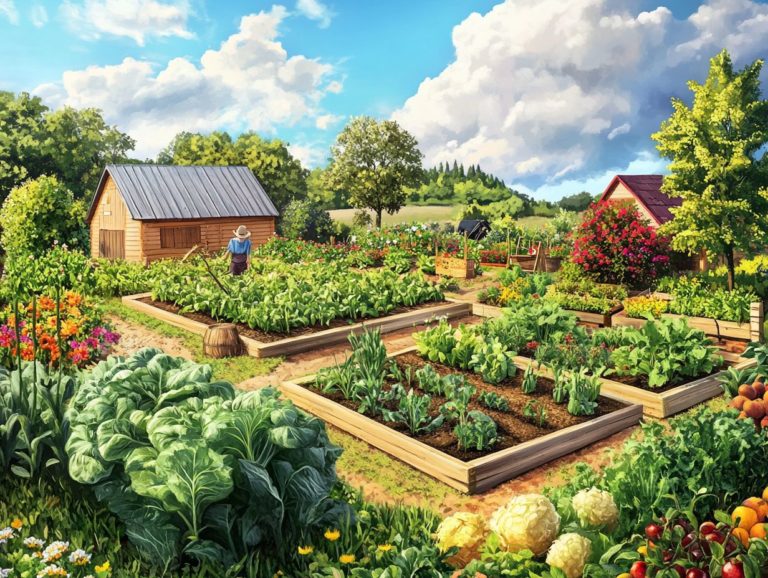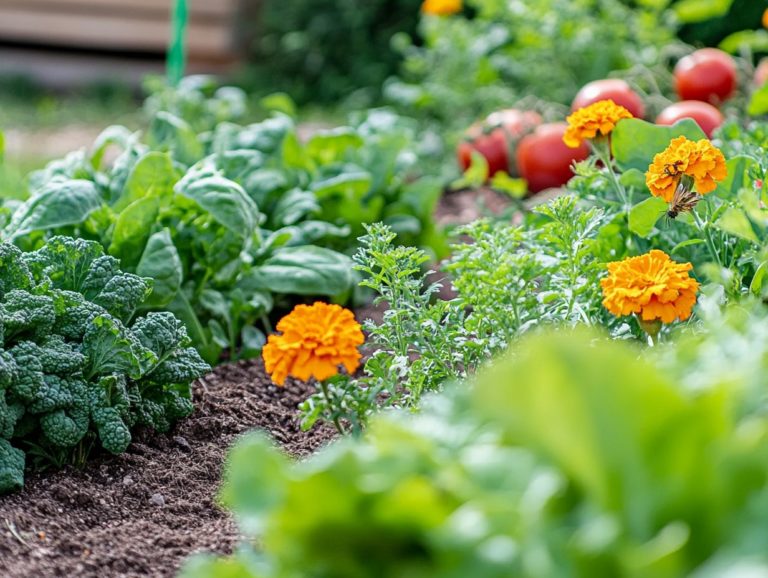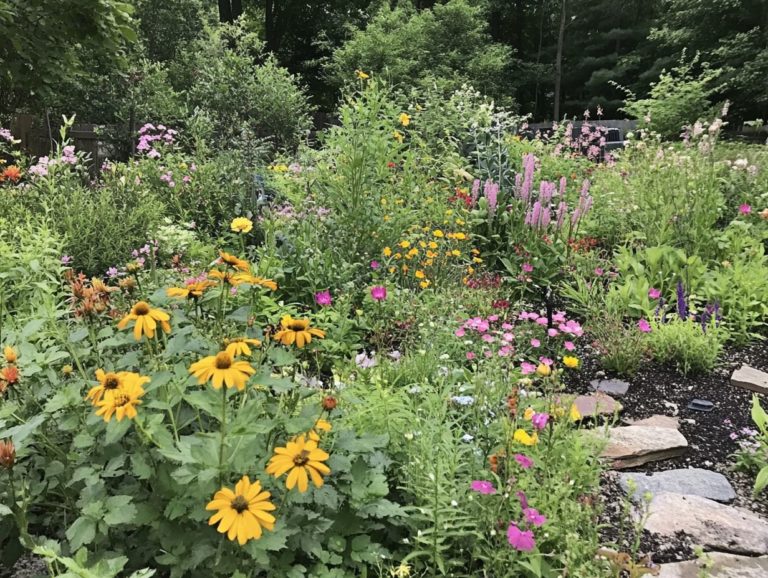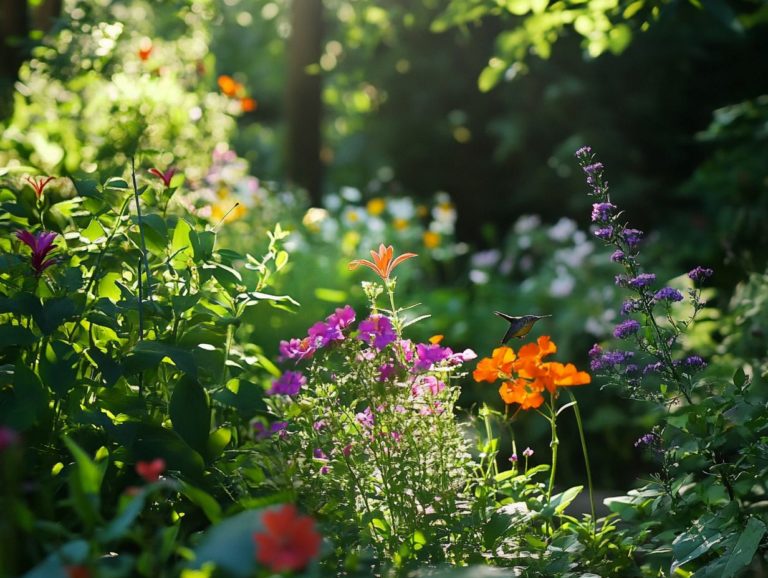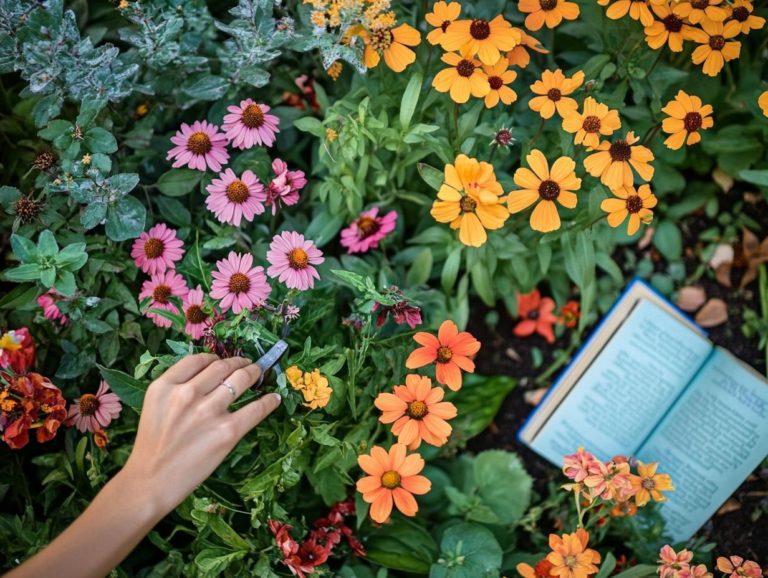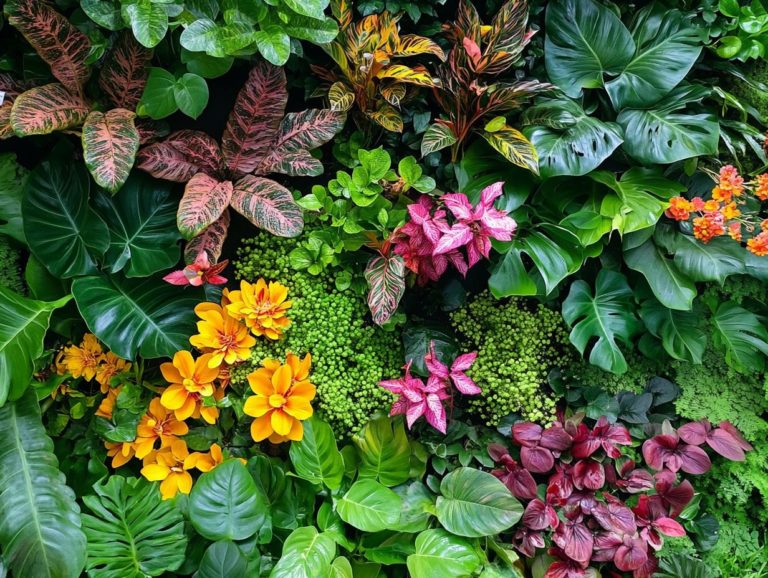“Top 10 Plants for Erosion Control”
Erosion can wreak havoc on landscapes. The right plants act as nature s shield, particularly those recognized as the best erosion control options.
Steep slopes, sandy soils, and areas prone to heavy rainfall can all benefit from specific plants that transform your approach to erosion management.
Get ready to discover the top 10 plants that can save your soil, ranging from resilient groundcovers to robust trees!
You ll also find guidance on choosing the right erosion control plants, avoiding common pitfalls, and maintenance tips that help your greenery thrive and safeguard the soil.
Let s dive in!
Contents
- Key Takeaways:
- 1. Groundcover Plants for Erosion Control
- 2. Shrubs for Erosion Control
- 3. Trees for Erosion Control
- 4. Native Plants for Erosion Control
- 5. Ornamental Grasses for Erosion Control
- 6. Perennial Flowers for Erosion Control
- 7. Plants That Help Stabilize Slopes
- 8. Plants That Absorb Water and Prevent Erosion
- 9. Plants That Have Deep Root Systems for Erosion Control
- 10. Plants That Thrive in Poor Soil Conditions for Erosion Control
- How to Choose the Right Plants for Erosion Control?
- What Are the Key Factors to Consider When Choosing Plants for Erosion Control?
- What Are the Most Common Mistakes Made When Choosing Plants for Erosion Control?
- How Can Plants Help Prevent Erosion?
- What Are Some Additional Benefits of Using Plants for Erosion Control?
- What Are Some Tips for Maintaining Plants Used for Erosion Control?
- Frequently Asked Questions
- What are the top 10 plants for erosion control?
- Why are these plants considered the top 10 for erosion control?
- Can these plants be used in any type of soil?
- Do these plants require a lot of maintenance?
- Can these plants be used in both residential and commercial settings?
- Are there any additional benefits to using these plants for erosion control?
Key Takeaways:
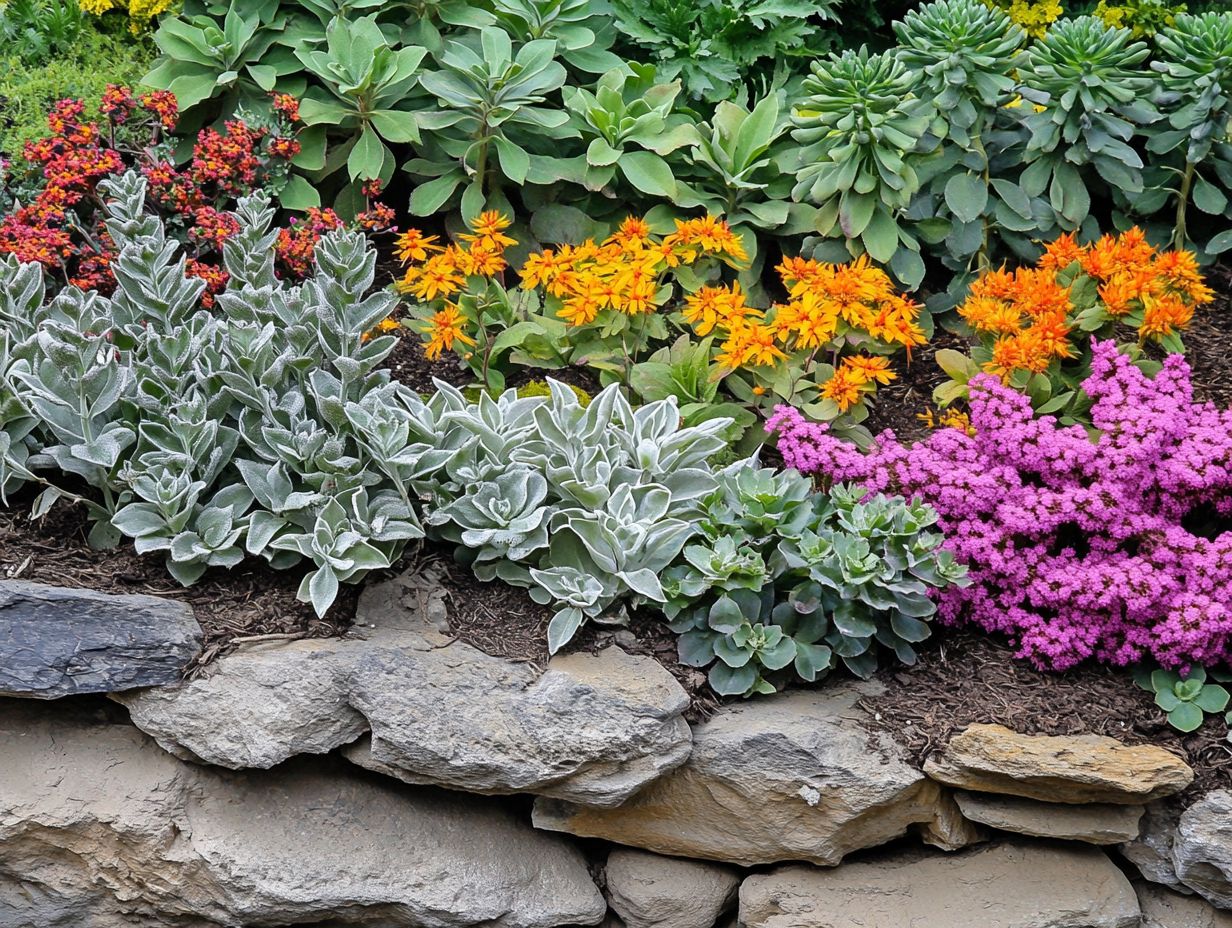
- Opt for native plants with strong roots to prevent erosion effectively.
- Ornamental grasses and perennial flowers are beautiful and effective in controlling erosion.
- Proper maintenance and understanding soil conditions are crucial for successful erosion control with plants.
1. Groundcover Plants for Erosion Control
Groundcover plants are essential in controlling erosion, especially in sustainable landscaping projects. Their goal is to maintain soil integrity while enhancing the visual appeal of your outdoor space.
These plants stabilize the soil and enrich the nutrient content of the topsoil. They’re a favored choice for both landscape architects and homeowners.
As the demand for effective erosion solutions rises, researchers continuously identify various plant species that thrive in diverse conditions.
Take, for example, Lomandra species. They are celebrated for their robust root systems, which effectively combat soil erosion while flourishing in various environments.
Native grasses like Themeda and Microlaena also excel in forming a dense mat that stabilizes the ground and curbs runoff.
Researchers compare methods and analyze soil to assess how these plants perform under stressors like drought and heavy rainfall.
Such investigations showcase the effectiveness of groundcover plants in enhancing soil health and their role in sustainable landscaping practices.
2. Shrubs for Erosion Control
Shrubs play a vital role in erosion control strategies. They offer aesthetic appeal and significantly enhance soil stability in vulnerable areas.
Choosing the right shrub varieties can make a remarkable difference in combating soil erosion, especially in regions prone to heavy rainfall or landslides.
Utilizing species like Dietes and Agapanthus, with their strong root systems, effectively anchors the soil and prevents degradation.
Consider shrubs like Lantana and native flowering varieties. They thrive in various climates and feature extensive lateral roots that stabilize the soil.
Ongoing research emphasizes the importance of selecting these shrubs based on their growth patterns and adaptations to local environments.
As you deepen your understanding of how these plants interact with soil, stay updated on the most effective practices. This ensures resilience against erosion and promotes biodiversity in urban settings.
Don’t wait until erosion harms your landscape choose the right plants today!
3. Trees for Erosion Control
Trees are essential for controlling erosion. Their deep roots reach far into the ground, which helps hold the soil together, providing stability and enhancing its strength.
Choosing the right tree species can dramatically reduce soil erosion and improve the overall health of the ecosystem. By incorporating trees into your sustainable landscaping designs, you can create a strong barrier against erosion and protect nutrient-rich topsoil.
Consider species like willows and poplars. They are celebrated for their extensive root systems, which effectively anchor soil and minimize runoff. Oaks not only offer similar protective benefits, but they also enhance biodiversity by providing habitats for diverse wildlife.
These trees prevent soil displacement and improve water absorption, leading to healthier soil conditions. When you thoughtfully integrate these species into landscaping projects, you maximize their ecological benefits and elevate the aesthetic appeal of your environment.
This strategic approach fosters a balanced ecosystem where both plant and animal life can thrive. Ultimately, it contributes to greater ecological resilience.
4. Native Plants for Erosion Control
Native plants are crucial for effective erosion control practices. They foster biodiversity while ensuring the strength and stability of local ecosystems.
Their extensive root systems not only anchor the soil but also improve environmental health. This makes them prime candidates for your sustainable landscaping projects.
Research shows many benefits of incorporating native plants. Landscape architects like you should prioritize these solutions in your designs.
Take switchgrass and purple coneflower as examples. These species adapt well to local conditions, reducing runoff and improving soil retention. They thrive in their native habitats and need minimal maintenance, making them a cost-effective choice for long-term erosion control.
Studies indicate that the deep root structures of these plants enhance soil aeration and nutrient cycling, which is the process of moving nutrients through the soil. By integrating these plants, you benefit the environment and support local wildlife.
This creates a balanced ecosystem that resists erosion and enhances plant diversity. Are you ready to embrace native plants in your landscaping?
5. Ornamental Grasses for Erosion Control
Ornamental grasses are gaining recognition for their ability to control erosion while improving the aesthetic quality of your landscape design. These resilient plants stabilize soil with their extensive root systems and require minimal maintenance.
By incorporating varieties such as Pennisetum, you can enhance soil strength and create visually appealing spaces that effectively combat erosion. Along with Pennisetum, consider other options like Miscanthus and Panicum.
These grasses, with their tall structures and dense foliage, create a natural barrier against wind and water runoff. Their thick, fibrous roots anchor the soil, preventing displacement and fostering a healthier ecosystem.
The seasonal color changes and varied textures contribute to the beauty of gardens, parks, and urban environments. This allows you to craft spaces that blend functionality with visual appeal.
These grasses can be grouped or layered effectively, making them versatile for both residential and commercial landscapes. This enhances their role in soil stabilization initiatives. Ready to transform your landscape?
6. Perennial Flowers for Erosion Control
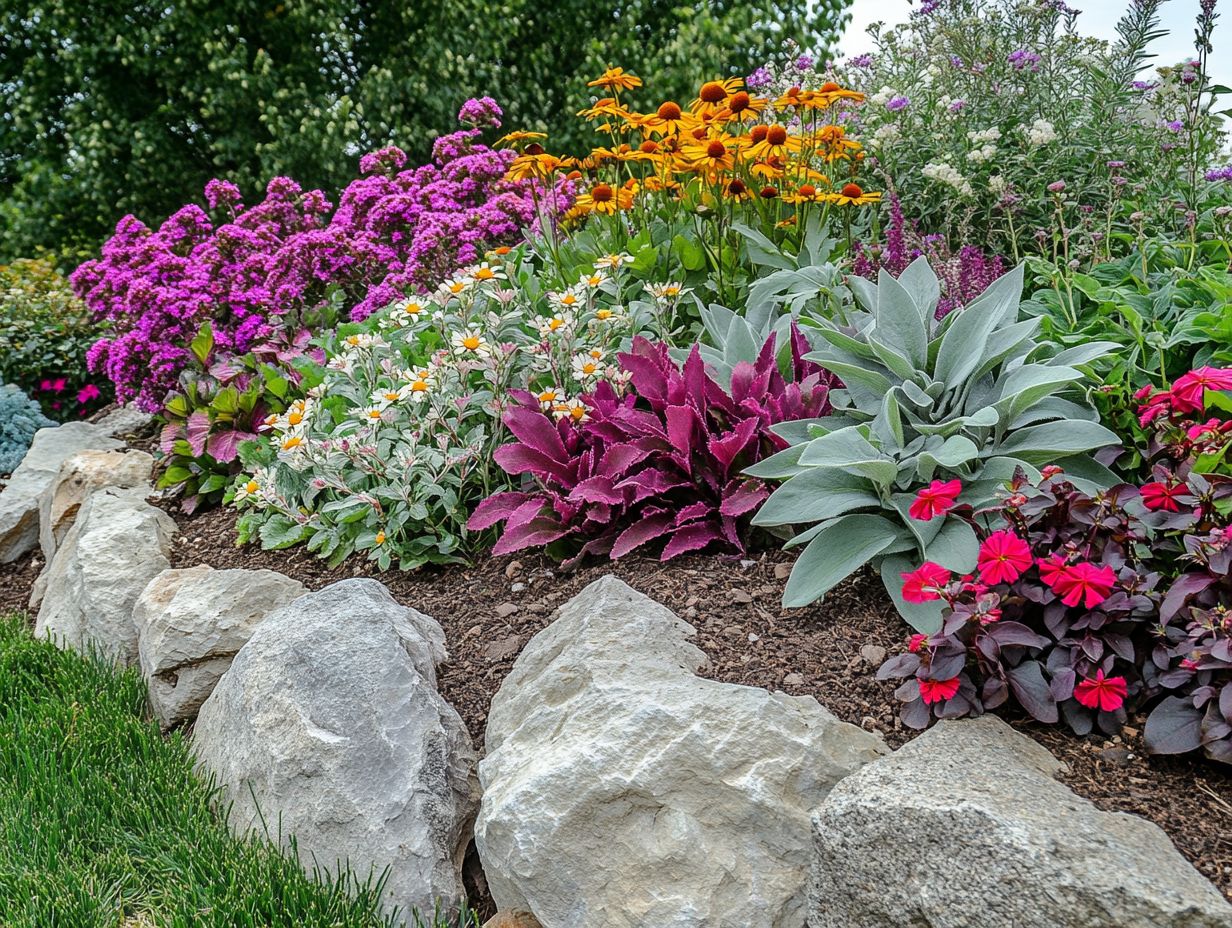
Perennial flowers do more than beautify your landscape. They also play a crucial role in preventing the loss of soil by enhancing soil health through their robust root systems.
By selecting varieties like Agapanthus orientalis, you can effectively combat soil erosion while also contributing to the creation of healthy soil that is full of nutrients. This dual purpose makes perennial flowers an outstanding choice for any sustainable landscaping endeavor focused on erosion prevention.
These amazing plants have powerful root systems that work hard to bind the soil together, reducing the chances of runoff and loss during heavy rains. Varieties such as Echinacea purpurea and Rudbeckia hirta not only attract pollinators but also help stabilize the ground, ensuring a thriving ecosystem.
When integrated into a comprehensive erosion control strategy, these plants can grace slopes and banks, creating a vibrant tapestry while providing essential cover that mitigates the impact of rainfall. The decaying leaves from these plants enrich the soil, further boosting its resilience and overall health.
7. Plants That Help Stabilize Slopes
Plants that help stabilize slopes are vital for effective erosion control, especially in areas vulnerable to landslides and soil degradation. By utilizing species with extensive root systems, such as certain native plants and shrub varieties, you can significantly enhance soil strength and create a natural barrier against erosion.
Ongoing research continues to unveil optimal plant selections that not only stabilize slopes but also bolster the health of the surrounding ecosystem. For instance, deep-rooted grasses like fescue and native wildflowers such as lupines excel at anchoring soil effectively. Shrubs like dogwoods and willows provide the added advantage of absorbing excess water.
Studies have shown that these plants do more than just prevent soil dislodgment; they also foster biodiversity, creating habitats for various organisms. Researchers are actively looking into how specific root structures contribute to slope stability, comparing performance across different environments.
You can see the real-life applications of these findings in restoration projects alongside highways and riverbanks. Here, strategically planted flora has dramatically improved soil retention and decreased the risk of landslides.
8. Plants That Absorb Water and Prevent Erosion
Plants that absorb water play a vital role in preventing erosion, helping to maintain soil health and protect nutrient-rich topsoil from runoff. When you integrate such species into your sustainable landscaping designs, you not only combat erosion but also enhance the overall resilience of the ecosystem.
By prioritizing native plants that excel in water absorption, you can create lush environments that offer both aesthetic beauty and functional stability. These plants are deeply rooted in the local environment and possess unique adaptations that enable them to thrive under various conditions while efficiently managing water.
For example, species like switchgrass and milkweed not only fortify the soil with their extensive root systems but also attract beneficial pollinators, further boosting ecosystem health. To successfully incorporate these native varieties into your landscape, think about layering them in your garden beds, grouping them according to their specific water requirements.
This thoughtful design not only strengthens erosion control but also nurtures a vibrant habitat that sustains local wildlife. Choose native plants today to create a beautiful and resilient landscape!
9. Plants That Have Deep Root Systems for Erosion Control
Deep-rooted plants are essential for preventing erosion. They stabilize the soil and reduce runoff in vulnerable areas.
Ongoing research has documented the effectiveness of these plants, highlighting their importance in sustainable landscaping efforts.
By selecting native grasses and other perennials with extensive root systems, you can enhance soil strength and contribute to long-term erosion management.
For instance, deep-rooted prairie grasses and native shrubs anchor the soil and improve water absorption, preventing surface runoff. These plants also promote biodiversity.
You can utilize these plants in bio-retention areas and green roofs, where their roots thrive even in limited soil. The evidence shows that integrating these natural solutions into landscaping offers a resilient approach to tackling erosion challenges.
10. Plants That Thrive in Poor Soil Conditions for Erosion Control
Plants that thrive in poor soil conditions are invaluable for erosion prevention. They provide effective solutions where traditional species often struggle.
These resilient varieties stabilize the soil and enhance overall soil health, making them essential for sustainable landscaping.
Consider species like the common bluebell and foxglove. They flourish in nutrient-deficient environments, making them ideal choices for rehabilitation projects.
Their deep roots anchor the soil and help retain moisture, benefiting surrounding vegetation.
Researchers are discovering the significant potential of native species that can combat erosion while promoting ecological integrity. Identifying new varieties that endure harsh conditions is crucial for enhancing biodiversity and healthier ecosystems.
How to Choose the Right Plants for Erosion Control?
Selecting the right plants for erosion control is crucial. Consider your soil type, local conditions, and what looks good in your landscape.
To effectively tackle erosion, assess the soil type; sandy soils require different plants than clay or loamy soils. Understanding your local climate including rainfall patterns and temperature ranges will significantly affect plant survival and growth.
You should also consider your aesthetic preferences regarding color, texture, and seasonal interest. This will help you create visually stunning landscapes.
Research shows that using native plants is beneficial. They are typically better suited to local conditions, demand less maintenance, and provide vital habitats for wildlife.
This comprehensive approach to erosion control benefits both the environment and your landscape s beauty. Transform your landscape today!
What Are the Key Factors to Consider When Choosing Plants for Erosion Control?
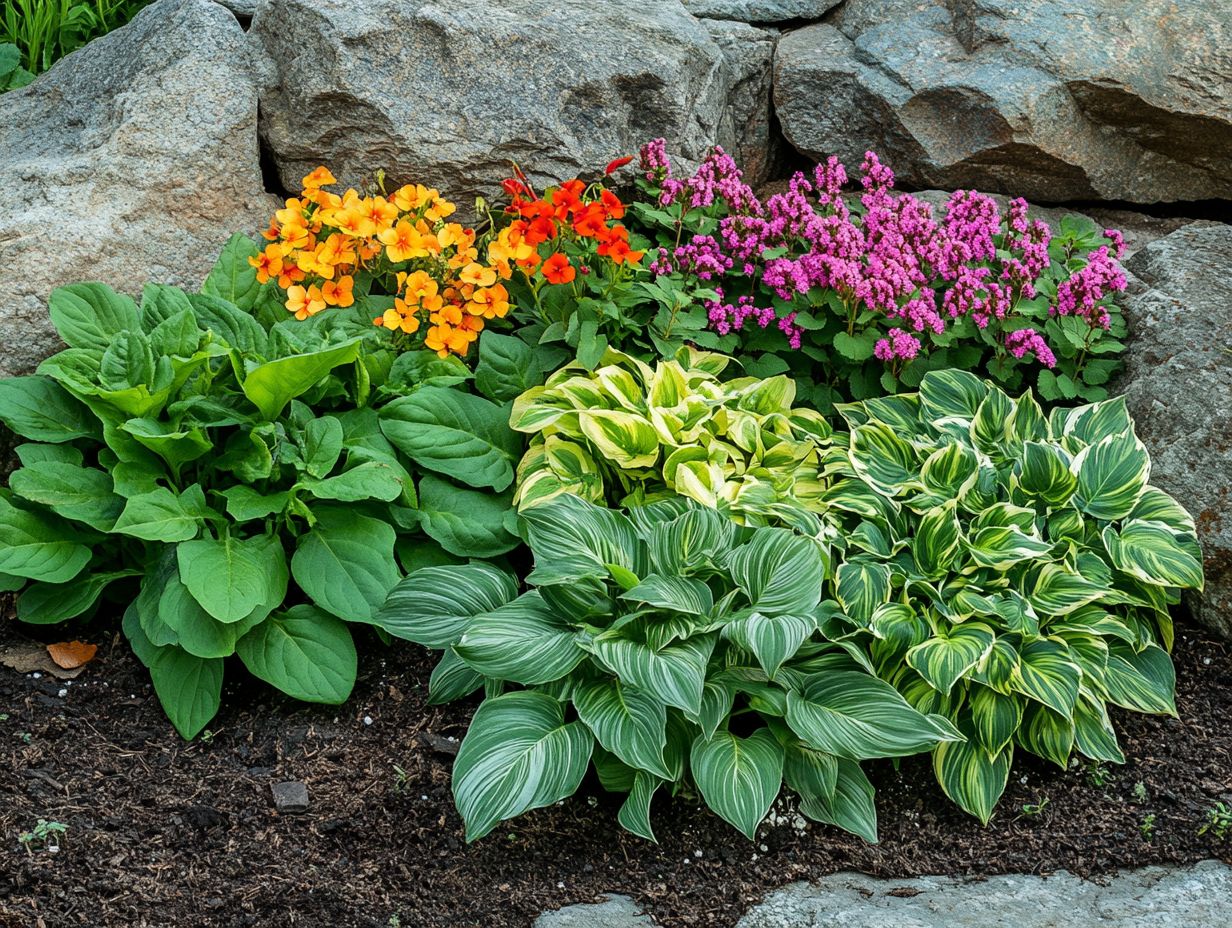
When selecting plants for erosion control, you need to consider several key factors to ensure effective keeping the soil in place and balance with nature. These factors include soil type, climate conditions, and the desired visual appeal of your landscaping.
Soil type is an important part; some plants thrive in sandy soils, while others flourish in clay-rich environments. Understanding your local climate conditions is equally important. This knowledge helps you choose species that can endure heat, drought, or excessive moisture, helping them last longer.
Don t overlook the visual appeal of your choices. Incorporating attractive plants can elevate the overall landscape while providing functional benefits. Strong roots not only stabilize the soil but also enhance water absorption and reduce runoff. Deep-rooted native grasses and perennials are your best friends for erosion control!
By merging functional considerations with your aesthetic goals, you can achieve effective erosion control while beautifying your space.
What Are the Most Common Mistakes Made When Choosing Plants for Erosion Control?
When choosing plants for erosion control, common missteps often arise from a lack of understanding of the specific conditions and needs of the environment. This can lead to ineffective plant selections that fail to stabilize soil adequately. Many gardeners overlook the importance of selecting native species that are well-adapted to local conditions, resulting in poor performance and increased erosion.
Neglecting to pay adequate attention to local climate, soil types, and moisture levels can amplify these challenges. Ignoring the growth habits and root systems of the plants you select may lead to issues like shallow root structures that provide insufficient stabilization.
To avoid these common errors, it’s essential to thoroughly research local plant varieties that thrive in your specific regional conditions. Consulting with local gardening experts or extension services can provide you with valuable insights, ensuring that the plants you choose flourish and effectively contribute to your erosion control efforts.
How Can Plants Help Prevent Erosion?
Plants are essential in preventing erosion by stabilizing soil with their root systems. They anchor the soil and reduce runoff, enhancing the integrity of nutrient-rich topsoil. By incorporating various species into your landscaping designs especially those with strong roots you can create barriers against erosion while fostering a healthy ecosystem.
Certain species, such as native grasses and deep-rooted shrubs, excel in this role. Take switchgrass, for example; its deep taproots not only keep the soil intact but also reach into deeper layers, improving both water absorption and aeration. Ground covers like creeping thyme or clover can protect the surface from heavy rains.
When strategically planted, these plants act as a green infrastructure solution, using plants to solve environmental issues. This promotes sustainable landscaping that bolsters soil health, conserves water, and provides habitats for beneficial insects.
Together, these plants do more than ensure soil stability; they contribute to a thriving ecosystem that sustains itself over time.
Start your erosion control project today! Choose the right plants and watch your landscape thrive!
What Are Some Additional Benefits of Using Plants for Erosion Control?
Beyond their primary role in erosion control, incorporating plants offers a wealth of additional benefits that elevate both the environmental and visual appeal of your landscape. By promoting biodiversity, enhancing soil health, and providing habitats for wildlife, plants also enrich the visual appeal of your environment.
When you integrate a variety of species into your erosion control strategies, you have the opportunity to create vibrant spaces that not only combat erosion but also contribute positively to the overall ecosystem. Consider using deep-rooted perennials like switchgrass and native wildflowers; they effectively secure the soil while attracting pollinators to boost both plant diversity and ecosystem health.
These species do more than just stabilize the soil they enrich the surrounding area by contributing organic matter that enhances nutrient availability and improves soil structure. Using ground cover plants like creeping thyme or sedum adds beauty and helps retain moisture, creating lush green carpets that captivate the eye while serving a vital role in moisture retention.
You can transform erosion-prone areas into vibrant landscapes filled with life! The collective impact of such plantings has the potential to create thriving, multifaceted environments that support both human enjoyment and environmental sustainability.
What Are Some Tips for Maintaining Plants Used for Erosion Control?
Maintaining plants used for erosion control is essential for ensuring their long-term effectiveness and health within your landscape. Consistent care practices enhance soil health while supporting the sustained efficacy of these plants in combating erosion.
By implementing tried-and-true tips for plant maintenance like regular watering, mulching, and monitoring for pests you can maximize the benefits of your erosion control strategies and contribute meaningfully to sustainable landscaping efforts.
These practices safeguard the physical integrity of your soil while promoting biodiversity within the surrounding ecosystem. Regularly assessing moisture levels ensures your plants receive adequate hydration, especially during drier months. Mulching is your secret weapon, helping to retain moisture and suppress those pesky weeds that compete for nutrients.
It s wise to conduct periodic inspections for pests and diseases, addressing any issues promptly to prevent them from spreading. By fostering a nurturing environment, you significantly enhance the durability of your erosion control plants, ultimately creating a more stable and resilient landscape over time.
Frequently Asked Questions
What are the top 10 plants for erosion control?
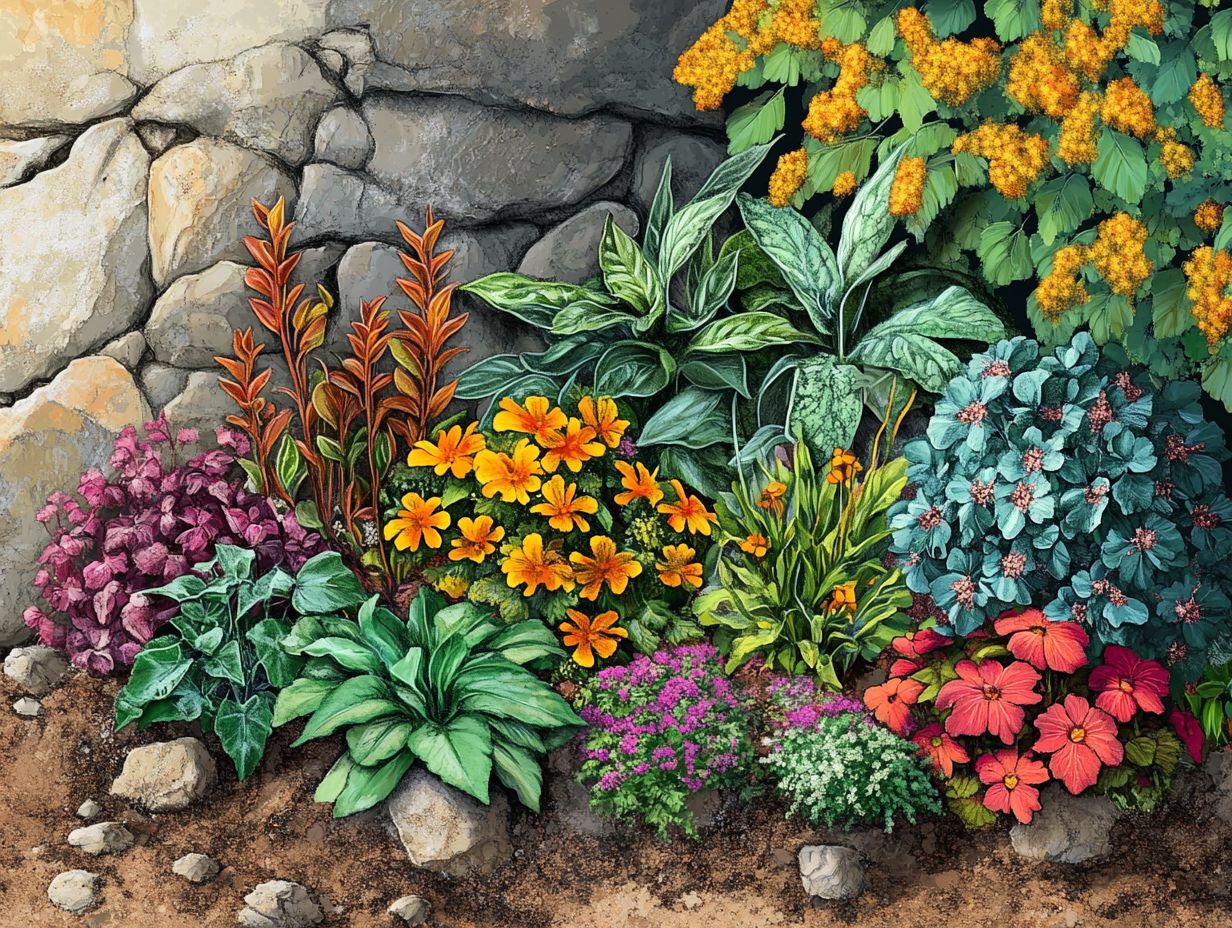
- 1. Switchgrass
- 2. Pampas Grass
- 3. Buffalo Grass
- 4. Blue Grama Grass
- 5. Beachgrass
- 6. Big Bluestem
- 7. Needlegrass
- 8. Bush Honeysuckle
- 9. St. John s Wort
- 10. Creeping Juniper
Why are these plants considered the top 10 for erosion control?
These plants have deep root systems that help hold the soil in place, preventing erosion. They are also hardy and able to withstand harsh weather conditions, making them ideal for erosion-prone areas.
Can these plants be used in any type of soil?
Most of these plants are adaptable and can thrive in a variety of soil types, including sandy, loamy, and even clay soils. However, it is always best to check the specific needs of each plant before planting.
Do these plants require a lot of maintenance?
Most of these plants are low-maintenance and require minimal care once established. However, regular watering and occasional pruning may be necessary to ensure optimal growth and erosion control.
Can these plants be used in both residential and commercial settings?
Yes, these plants are suitable for both residential and commercial settings. They can be used in gardens, lawns, parks, and other open spaces to help prevent erosion and maintain the integrity of the land.
Are there any additional benefits to using these plants for erosion control?
Aside from their ability to prevent erosion, these plants also offer other benefits such as attracting wildlife, providing shade, and adding visual interest to the landscape. They also help improve soil health and reduce the need for chemical fertilizers.
Start your erosion control project today and watch your landscape thrive!

